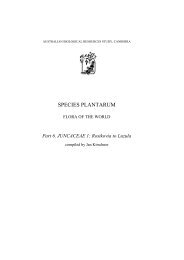Vol. 1 part 2 - Species Plantarum Programme
Vol. 1 part 2 - Species Plantarum Programme
Vol. 1 part 2 - Species Plantarum Programme
You also want an ePaper? Increase the reach of your titles
YUMPU automatically turns print PDFs into web optimized ePapers that Google loves.
CHRYSOBALANACEAE (Parinari)<br />
different gender, and have accepted that original publication of names under Parinarium<br />
should be maintained under Parinari, with appropriate correction of the gender of their<br />
epithets. Index Kewensis listed all specific names up to Supplement 7 (1929) under<br />
Parinarium, but from Supplement 8 (1933) onwards under Parinari, irrespective of which<br />
was adopted by the authors of the species names. A few authors, however, notably<br />
J.E.Dandy, have argued that Parinari and Parinarium are different names and not mere<br />
variants and that a new combination is required to transfer an epithet from one to the other.<br />
This might have been supported by the International Code up to 1994 in its list of conserved<br />
generic names, where, for example, Pupalia and Pupal, Canavalia and Canavali, and<br />
Cajanus and Cajan respectively, were listed as different names, though the examples of<br />
Naravelia and Naravel, and Vochysia and Vochy were listed as mere orthographic variants<br />
respectively. However, from 1994 onwards the list of conserved names has been amended so<br />
that Pupalia, Canavalia and Cajanus are listed as orthographic variants, as are Naravelia and<br />
Vochysia. The case of Parinari and Parinarium thus seems to be clearly resolved in favour<br />
of treating them also as orthographic variants, not requiring new combinations when epithets<br />
are transferred from one to the other. In this account, when names were originally published<br />
under Parinarium, this is indicated after the date of publication.<br />
1 Stomatal crypts absent from leaf lower surface; leaf lower surface<br />
glabrous or with a persistent lanate pubescence and then with large<br />
persistent stipules 7–40 mm long<br />
[sect. Anareolata]<br />
2 Leaf lower surface glabrous; stipules small and caducous<br />
3 Leaves elliptic to oblong or obovate-elliptic, 9.5–20.5 × 4.5–8.5 cm;<br />
primary veins 11–16 pairs; panicles large and silvery pubescent<br />
1. P. argenteosericea<br />
3: Leaves ovate, 5–9 × 2–4.5 cm; primary veins 7–11 pairs; panicles<br />
small and subsericeous brown pubescent<br />
2. P. canarioides<br />
2: Leaf lower surface densely lanate pubescent, but when removed no<br />
stomatal crypts present; stipules large and persistent, 7–40 mm long,<br />
3–5 mm broad at base<br />
4 Leaves oblong-lanceolate, 5–18 cm long on flowering branches,<br />
thickly coriaceous, with base cuneate<br />
3. P. elmeri<br />
4: Leaves elliptic to oblong, 11–28 cm long, chartaceous, with base rounded 4. P. parva<br />
1: Stomatal crypts present on leaf lower surface; leaf lower surface lanate or<br />
at least pubescent in crypts; stipules usually small (larger in species 5–8)<br />
[sect. Parinari]<br />
5 Stipules 10–40 mm long, persistent, semi-amplexicaul<br />
6 Leaf base cuneate or subcuneate; young branches with dense stiff<br />
ferrugineous hairs<br />
5. P. rodolphii<br />
6: Leaf base usually cordate or subcordate, sometimes rounded; young<br />
branches usually grey- to brown-tomentellous to -puberulous, without<br />
stiff ferrugineous hairs (but ferrugineous-tomentose in P. alvimii)<br />
7 Leaf lower surface with a dense golden-ferrugineous pubescence<br />
obscuring stomatal cavities; leaf base rounded or only slightly<br />
subcordate; with marginal glands at end of primary veins<br />
6. P. hypochrysea<br />
7: Leaf lower surface grey to brown tomentose; leaf base cordate or<br />
subcordate; without marginal glands<br />
8 Leaf apex bluntly acute; primary veins 17–25 pairs 7. P. alvimii<br />
8: Leaf apex acuminate; primary veins 14–16 pairs 8. P. campestris<br />
5: Stipules caducous, usually small (1–8 mm), if larger not clasping stem<br />
9 Plants rhizomatous suffructices, usually less than 30 cm tall, rarely up<br />
to 2 m<br />
10 Leaf lower surface with white-lanate pubescence obscuring the<br />
stomatal cavities; leaves oblong to elliptic, cuneate at base; primary<br />
veins 11–16 pairs<br />
9. P. obtusifolia<br />
199












